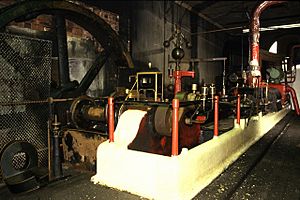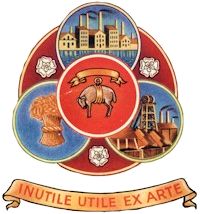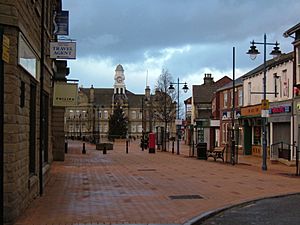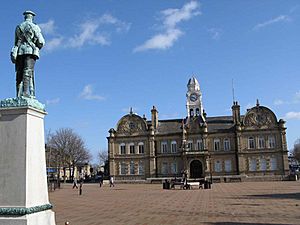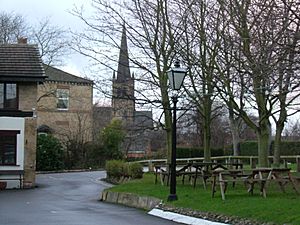Ossett facts for kids
Quick facts for kids Ossett |
|
|---|---|
| Town | |
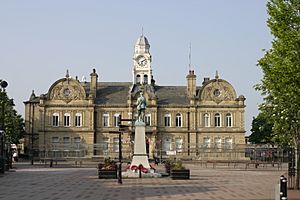 Ossett Town Hall |
|
| Population | 21,861 (2021 census) |
| OS grid reference | SE279205 |
| • London | 186 mi SE |
| Metropolitan borough | |
| Metropolitan county | |
| Region | |
| Country | England |
| Sovereign state | United Kingdom |
| Post town | OSSETT |
| Postcode district | WF5 |
| Dialling code | 01924 |
| Police | West Yorkshire |
| Fire | West Yorkshire |
| Ambulance | Yorkshire |
| EU Parliament | Yorkshire and the Humber |
| UK Parliament |
|
Ossett is a market town in the Wakefield area of West Yorkshire, England. It's located between Dewsbury, Horbury, and Wakefield. In 2021, about 21,861 people lived there. Ossett is part of the Heavy Woollen District, an area known for its textile industry.
Contents
History of Ossett
What's in a Name?
The name Ossett comes from an old English word. It might mean "the animal pen of a man named Osla" or "a pen often visited by blackbirds."
Early Beginnings
Ossett is mentioned in the 1086 Domesday Book. This book was a big survey of England ordered by William the Conqueror. Ossett was called "Osleset" back then. It was described as having enough land for three teams of eight oxen to plough. Four villeins (farmers who worked for a lord) and three bordars (small farmers) lived there.
Ossett's Industrial Past
For a long time, coal mining was a very important industry in Ossett, employing many people until the late 1960s. Coal has been mined here since the 1300s. In the 1800s, there were many coal pits, like Old Roundwood and Westfield. Some pits closed due to flooding or other reasons.
Ossett was also famous for its "shoddy" industry. This meant recycling old wool clothes to make new fabric. Unlike some towns where mostly women worked in textile mills, Ossett's mills had a good balance of men and women workers. The mills were usually small but known for making high-quality products.
A large company called Woodhead Manufacturing used to employ 1,500 people in Ossett. They made things like shock absorbers. This business closed in the early 1990s, and the area is now a housing estate. One old mill building on Church Street, which used to have Woodhead signs, was renovated into flats in 2016.
Second World War Events
During the Second World War, Ossett was accidentally bombed on September 16, 1940. Ten bombs fell, but luckily, no one was killed, though some properties were damaged.
Ossett as a Spa Town
For a short time in the 1800s, Ossett was a spa town. A local stonemason started it, inspired by famous spa towns like Harrogate. People came to use the waters, hoping they would help with skin problems. However, a plan in the 1870s to make Ossett a "second Harrogate" didn't work out, and the spa closed. The southeast part of town is still called "Ossett Spa."
How Ossett is Governed
Ossett has changed how it's governed over the years. It became a civil parish in 1866 and then a municipal borough in 1890. Since 1974, it has been part of the City of Wakefield district.
Ossett is part of the Ossett and Denby Dale area for national elections. This area is currently represented in Parliament by Jade Botterill from the Labour Party.
Locally, most of Ossett is in the "Ossett ward" for the city council. The southeastern part is in the "Horbury and South Ossett ward." These wards elect councillors to represent the area.
Ossett's Geography
Local Climate
Ossett has an oceanic climate, which is typical for most of the United Kingdom. This means it has mild temperatures and rainfall throughout the year.
| Climate data for Ossett, West Yorkshire 1981–2010 | |||||||||||||
|---|---|---|---|---|---|---|---|---|---|---|---|---|---|
| Month | Jan | Feb | Mar | Apr | May | Jun | Jul | Aug | Sep | Oct | Nov | Dec | Year |
| Mean daily maximum °C (°F) | 6 (43) |
6.2 (43.2) |
8.8 (47.8) |
11.6 (52.9) |
15.3 (59.5) |
18.1 (64.6) |
20.1 (68.2) |
19.1 (66.4) |
17 (63) |
12.9 (55.2) |
8.7 (47.7) |
6.1 (43.0) |
12.5 (54.5) |
| Mean daily minimum °C (°F) | 0.8 (33.4) |
0.5 (32.9) |
2.3 (36.1) |
3.7 (38.7) |
6.1 (43.0) |
8.7 (47.7) |
10.9 (51.6) |
10.9 (51.6) |
9.1 (48.4) |
6.4 (43.5) |
3.3 (37.9) |
1 (34) |
5.3 (41.6) |
| Average precipitation mm (inches) | 111.5 (4.39) |
70.3 (2.77) |
82.2 (3.24) |
76.9 (3.03) |
62.4 (2.46) |
78.2 (3.08) |
63.7 (2.51) |
81.4 (3.20) |
75.8 (2.98) |
107.7 (4.24) |
104.5 (4.11) |
114 (4.5) |
1,028.6 (40.51) |
| Average rainy days | 15.7 | 13.2 | 13.7 | 10.9 | 10.9 | 11.5 | 10.1 | 11.9 | 11.4 | 14.1 | 15.8 | 15.2 | 154.4 |
| Mean monthly sunshine hours | 51.5 | 64.8 | 96 | 134.2 | 167.1 | 153.5 | 172.5 | 161 | 126.6 | 101.3 | 57.8 | 50.2 | 1,336.5 |
| Source: Met Office | |||||||||||||
 |
Batley | Gawthorpe Tingley | Kirkhamgate |  |
| Dewsbury | Wakefield | |||
| Thornhill | Netherton | Horbury |
Population and Economy
In 2021, Ossett had a population of 21,861. Because it's close to the M1 motorway, Ossett has become a popular place for people who work in Leeds to live. This has made housing prices higher in the area.
What Businesses are in Ossett?
Ossett still has some textile mills. For example, Ings Mill recycles textiles, and Burmatex Ltd makes carpet tiles. Edward Clay & Son Ltd produces felts for mattresses, and Wilson Briggs & Son handles textile waste.
The town is also home to two real ale breweries: Ossett Brewery and Bob's Brewing Company.
Important Landmarks
- Trinity Church was built in 1865. Its tall spire, which is 226 feet high, can be seen from far away.
- A red phone booth in Ossett town centre is a special building protected for its history.
- Ossett Town Hall celebrated its 100th birthday in June 2008.
- In Gawthorpe, a part of north Ossett, there's a well-known water tower.
Getting Around Ossett
Roads and Motorways
The Romans built a road from Halifax to Wakefield, which became a main road in 1741. Today, the modern Dewsbury Road follows a similar path. The M1 motorway runs east of Ossett and was opened in the late 1960s.
Train Travel History
Trains first came to Ossett in 1862. Ossett railway station opened in 1889 but closed in 1964. Today, Ossett is one of the largest towns in Britain without its own railway station. There are still railway yards nearby at Healey Mills. In 2009, there was a proposal to build a new railway station in Ossett.
Bus Services
Ossett has a bus station in the town centre, which was rebuilt in 2005. It has six stands and shows real-time bus information. The main bus company is Arriva Yorkshire. Buses run regularly to Wakefield and Dewsbury, and less often to Batley.
Education in Ossett
Ossett used to have its own Grammar School, which opened in 1735. It moved to a new building in 1906 and taught both boys and girls, which was quite new for the area. The Grammar School closed in 1969.
Today, Ossett has nine primary schools, including Gawthorpe Community Academy and Ossett Holy Trinity C of E Primary School. There is one main secondary school, Ossett Academy & Sixth Form College, which is on the site of the old Grammar School. There are also special schools like The Grange School and Highfield School for students with learning difficulties.
Religion in Ossett
Ossett has seven churches. In the 1700s and 1800s, the town was known for its many Nonconformist churches, which were Protestant churches separate from the main Church of England.
Trinity Church and Christ Church, South Ossett, are the two Anglican (Church of England) churches. St. Ignatius Roman Catholic Church was built in 1878. The Salvation Army has a building in Gawthorpe that also serves as a community centre. There is also a Kingdom Hall of Jehovah's Witnesses and a spiritualist church. The King's Way church is a Methodist and United Reformed church.
Sports in Ossett
Ossett has several sports clubs. Ossett Rugby plays at Southdale playing fields and has teams for men, ladies, and juniors. Ossett Cricket Club plays at Dimplewells.
In football, Ossett used to have two semi-professional teams, Ossett Town and Ossett Albion. In 2018, these two clubs decided to merge and are now called Ossett United. Other local football clubs include Ossett Common Rovers, Ossett Wanderers, and Ossett Panthers.
Culture and Media
Local Media
Local news and TV shows for Ossett come from BBC Yorkshire and ITV Yorkshire. You can listen to local radio stations like BBC Radio Leeds and Heart Yorkshire.
Local newspapers like the Wakefield Express and the Dewsbury Reporter cover news from Ossett. There's also a free magazine called The Ossett Review and a newsletter from The Ossett Civic Trust.
Events and Mentions
- Gawthorpe hosts the yearly World Coal-Carrying Championships on Easter Monday and a Maypole parade in May.
- The Ossett Beercart event happens on the first weekend of June.
- Ossett Gala takes place in July.
- The turning on of the Christmas lights is a popular community event.
- The town is mentioned in the song It's Grim Up North by The KLF.
- The video game "Worms" by Team17, a company once based in Ossett, has a level called "Welcome to Ossett."
Famous People from Ossett
- The astronomer Cyril Jackson (1903–1988) was born in Ossett. He even named an asteroid after an ancient name for the area.
- Benjamin Ingham (1712–1772), who started the Inghamite Methodists, was born in Ossett.
- Eli Marsden Wilson (1877–1965) was a successful artist from Ossett. He had many pictures shown at the Royal Academy.
- Thomas Cussons started the famous Cussons personal care brand (like Imperial Leather soap) in Ossett.
- Novelist Stan Barstow (1928–2011), who wrote A Kind of Loving, lived much of his life in Ossett.
- Crime novelist David Peace (born 1967) is from Ossett.
- Elaine Storkey (born 1944), a broadcaster and writer, grew up in Ossett.
- Helen Worth (born 1944), who plays Gail Platt in Coronation Street, was born and grew up in Ossett.
- Richard Wood, a footballer for Sheffield Wednesday F.C., is from Ossett.
- Barry Wood, a former England cricketer, was born and grew up in Ossett.
See also
 In Spanish: Ossett para niños
In Spanish: Ossett para niños



